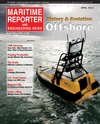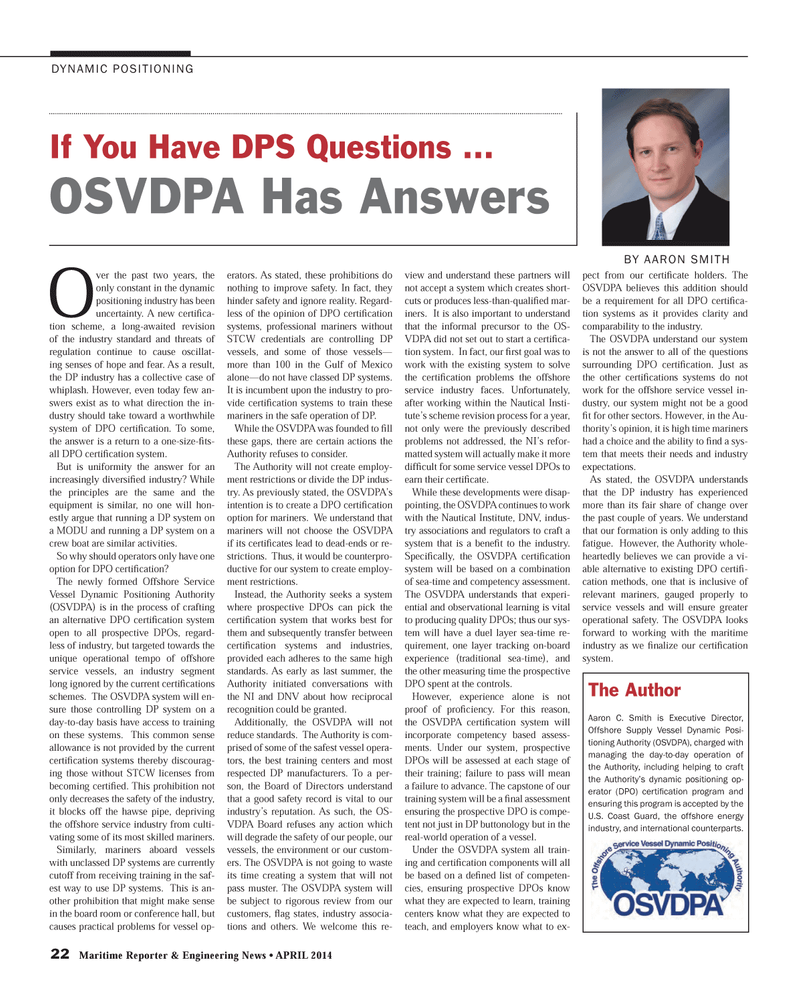
Page 22: of Maritime Reporter Magazine (April 2014)
Offshore Edition
Read this page in Pdf, Flash or Html5 edition of April 2014 Maritime Reporter Magazine
22 Maritime Reporter & Engineering News ? APRIL 2014 DYNAMIC POSITIONING Over the past two years, the only constant in the dynamic positioning industry has been uncertainty. A new certi Þ ca-tion scheme, a long-awaited revision of the industry standard and threats of regulation continue to cause oscillat-ing senses of hope and fear. As a result, the DP industry has a collective case of whiplash. However, even today few an- swers exist as to what direction the in-dustry should take toward a worthwhile system of DPO certiÞ cation. To some, the answer is a return to a one-size-Þ ts-all DPO certiÞ cation system. But is uniformity the answer for an increasingly diversiÞ ed industry? While the principles are the same and the equipment is similar, no one will hon- estly argue that running a DP system on a MODU and running a DP system on a crew boat are similar activities. So why should operators only have one option for DPO certiÞ cation? The newly formed Offshore Service Vessel Dynamic Positioning Authority (OSVDPA) is in the process of crafting an alternative DPO certiÞ cation system open to all prospective DPOs, regard-less of industry, but targeted towards the unique operational tempo of offshore service vessels, an industry segment long ignored by the current certiÞ cations schemes. The OSVDPA system will en- sure those controlling DP system on a day-to-day basis have access to training on these systems. This common sense allowance is not provided by the current certiÞ cation systems thereby discourag- ing those without STCW licenses from becoming certiÞ ed. This prohibition not only decreases the safety of the industry, it blocks off the hawse pipe, depriving the offshore service industry from culti- vating some of its most skilled mariners.Similarly, mariners aboard vessels with unclassed DP systems are currently cutoff from receiving training in the saf- est way to use DP systems. This is an- other prohibition that might make sense in the board room or conference hall, but causes practical problems for vessel op-erators. As stated, these prohibitions do nothing to improve safety. In fact, they hinder safety and ignore reality. Regard- less of the opinion of DPO certiÞ cation systems, professional mariners without STCW credentials are controlling DP vessels, and some of those vessels?more than 100 in the Gulf of Mexico alone?do not have classed DP systems. It is incumbent upon the industry to pro-vide certiÞ cation systems to train these mariners in the safe operation of DP. While the OSVDPA was founded to Þ ll these gaps, there are certain actions the Authority refuses to consider. The Authority will not create employ- ment restrictions or divide the DP indus- try. As previously stated, the OSVDPA?s intention is to create a DPO certiÞ cation option for mariners. We understand that mariners will not choose the OSVDPA if its certiÞ cates lead to dead-ends or re- strictions. Thus, it would be counterpro- ductive for our system to create employ-ment restrictions. Instead, the Authority seeks a system where prospective DPOs can pick the certiÞ cation system that works best for them and subsequently transfer between certiÞ cation systems and industries, provided each adheres to the same high standards. As early as last summer, the Authority initiated conversations with the NI and DNV about how reciprocal recognition could be granted.Additionally, the OSVDPA will not reduce standards. The Authority is com- prised of some of the safest vessel opera-tors, the best training centers and most respected DP manufacturers. To a per- son, the Board of Directors understand that a good safety record is vital to our industry?s reputation. As such, the OS- VDPA Board refuses any action which will degrade the safety of our people, our vessels, the environment or our custom-ers. The OSVDPA is not going to waste its time creating a system that will not pass muster. The OSVDPA system will be subject to rigorous review from our customers, ß ag states, industry associa- tions and others. We welcome this re- view and understand these partners will not accept a system which creates short-cuts or produces less-than-qualiÞ ed mar- iners. It is also important to understand that the informal precursor to the OS-VDPA did not set out to start a certi Þ ca-tion system. In fact, our Þ rst goal was to work with the existing system to solve the certiÞ cation problems the offshore service industry faces. Unfortunately, after working within the Nautical Insti-tute?s scheme revision process for a year, not only were the previously described problems not addressed, the NI?s refor- matted system will actually make it more difÞ cult for some service vessel DPOs to earn their certiÞ cate. While these developments were disap-pointing, the OSVDPA continues to work with the Nautical Institute, DNV, indus- try associations and regulators to craft a system that is a beneÞ t to the industry. SpeciÞ cally, the OSVDPA certi Þ cation system will be based on a combination of sea-time and competency assessment. The OSVDPA understands that experi- ential and observational learning is vital to producing quality DPOs; thus our sys-tem will have a duel layer sea-time re-quirement, one layer tracking on-board experience (traditional sea-time), and the other measuring time the prospective DPO spent at the controls. However, experience alone is not proof of proÞ ciency. For this reason, the OSVDPA certi Þ cation system will incorporate competency based assess-ments. Under our system, prospective DPOs will be assessed at each stage of their training; failure to pass will mean a failure to advance. The capstone of our training system will be a Þ nal assessment ensuring the prospective DPO is compe-tent not just in DP buttonology but in the real-world operation of a vessel.Under the OSVDPA system all train- ing and certiÞ cation components will all be based on a deÞ ned list of competen- cies, ensuring prospective DPOs know what they are expected to learn, training centers know what they are expected to teach, and employers know what to ex-pect from our certiÞ cate holders. The OSVDPA believes this addition should be a requirement for all DPO certiÞ ca-tion systems as it provides clarity and comparability to the industry. The OSVDPA understand our system is not the answer to all of the questions surrounding DPO certiÞ cation. Just as the other certiÞ cations systems do not work for the offshore service vessel in- dustry, our system might not be a good Þ t for other sectors. However, in the Au- thority?s opinion, it is high time mariners had a choice and the ability to Þ nd a sys- tem that meets their needs and industry expectations. As stated, the OSVDPA understands that the DP industry has experienced more than its fair share of change over the past couple of years. We understand that our formation is only adding to this fatigue. However, the Authority whole- heartedly believes we can provide a vi-able alternative to existing DPO certiÞ -cation methods, one that is inclusive of relevant mariners, gauged properly to service vessels and will ensure greater operational safety. The OSVDPA looks forward to working with the maritime industry as we Þ nalize our certi Þ cation system. If You Have DPS Questions ... OSVDPA Has Answers BY AARON SMITH The AuthorAaron C. Smith is Executive Director, Offshore Supply Vessel Dynamic Posi- tioning Authority (OSVDPA), charged with managing the day-to-day operation of the Authority, including helping to craft the Authority?s dynamic positioning op- erator (DPO) certi Þ cation program and ensuring this program is accepted by the U.S. Coast Guard, the offshore energy industry, and international counterparts. MR #4 (18-25).indd 22MR #4 (18-25).indd 224/4/2014 10:32:07 AM4/4/2014 10:32:07 AM

 21
21

 23
23
